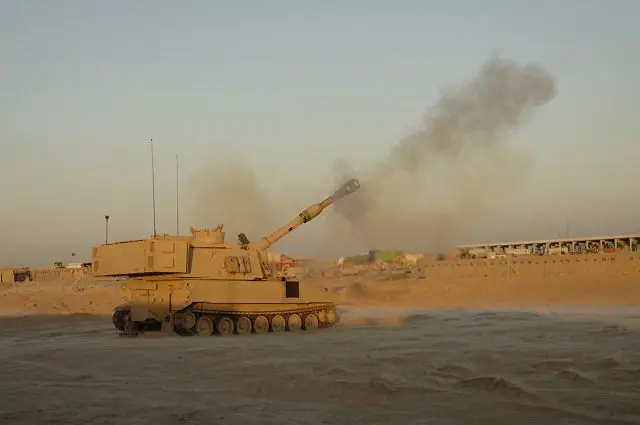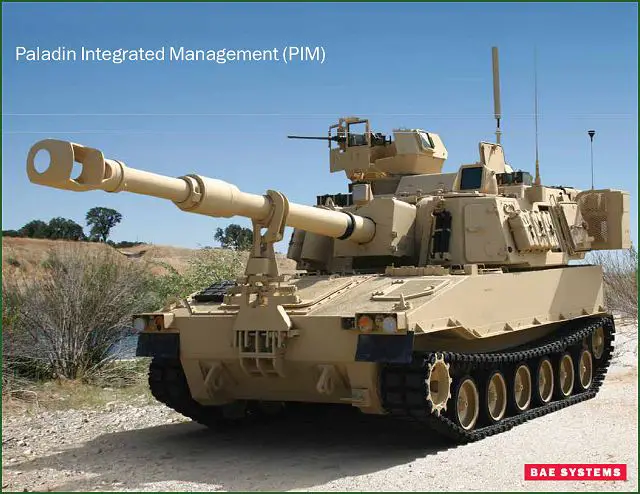| a | |||
Defense News - United States |
|||
Friday, September 2, 2011, 02:42 PM |
|||
PIM M109A6 Paladin the next generation of 155 mm artillery cannon howitzer for U.S. Army |
|||
WASHINGTON
--- The U.S. Army is developing a next-generation, 40-ton 155mm Howitzer
artillery cannon able to fire precision rounds, accommodate additional
armor protections and power more on-board electrical systems. |
|||
|
|||
The M109 Paladin Integrated Management, or PIM, is slated to begin low-rate initial production by 2013, and features a 600-volt on-board power system designed to accommodate emerging networking technologies as they become available. The PIM is the Army's modernization program for the 155mm self-propelled Howitzer fleet, said Lt. Col. Dan Furber, product manager, Self-Propelled Howitzer Systems. "The [space, weight and power] buy-back the PIM will provide is huge," Furber said. "It allows us to add additional armor to the platform and it allows us to add additional capabilities such as automation or electronic packages." The PIM's on-board power system harnesses technologies developed for the Non-Line-of-Sight Cannon, or NLOS-C, a 155mm Howitzer formerly developed for the Future Combat Systems, Manned-Ground Vehicles program. That program was canceled in 2009. "We've also harnessed the electric drives from the NLOS-C, which are faster than the hydraulic drives used in the existing fleet," Furber said. "With the electric drives and rammer, we are finding more consistent ramming of the round which allows for more consistent muzzle velocities and we are a little more accurate and responsive with the electric drives." |
|||
 PIM Paladin self-propelled howitzer |
|||
Prototypes
of the vehicle, built by BAE Systems, are now undergoing government testing
in preparation for a Low-Rate Initial Production decision. The PIM vehicle's
cannon rests on a chassis built with Bradley Fighting Vehicle common components
including engine, transmission and tracks.
"Being common with Bradley decreases the logistics footprint that echelons above brigades will have to manage," Furber said. "In the long term, it will decrease the amount of money needed to sustain the Bradley and Self-Propelled Howitzer fleets. We will only have to manage one engine, for example, in the supply chain, so there are economies of scale that are beneficial to the Army." The testing includes reliability, availability and maintainability mission testing as well as ballistic hull and turret testing. Both testing regimes are designed to prepare the program for a Milestone C production decision by 2013. Like other 155mm artillery systems, the Paladin will be configured to fire precision munitions such as the Excalibur and the Precision Guidance Kit. The PIM is being designed to provide key fire-support for a range of potential combat operations to include conventional, hybrid, irregular and counterinsurgency scenarios. "While PIM is associated with the heavy brigade combat team, it is a full-spectrum operational platform," Furber said. "For instance, it would allow the artillery crew supporting light infantry on a forward operating base to be protected from indirect fires -- something towed artillery pieces are not able to do." The PIM includes a sustained rate of fire of one round per-minute and a maximum rate of fire of four rounds per-minute, said Ed Murray, Department of the Army Systems Coordinator - Artillery. The Army plans to build 580 new Paladin PIM sets. Each set includes a self-propelled howitzer and an ammunition resupply vehicle. The existing fleet of M109A6 Howitzers are nearing obsolescence. Those weapons were originally designed in the 1950s and produced in the 1960s. As a result, the current fleet exceeds its weight and power capacity and does not provide for growth in mobility and force protection, thus emphasizing that the PIM program is necessary to address the existing capability gaps for self-propelled artillery. |
|||
PIM M109A6 Paladin the next generation of 155 mm artillery cannon howitzer for U.S. Army 0209112
- Posted On















